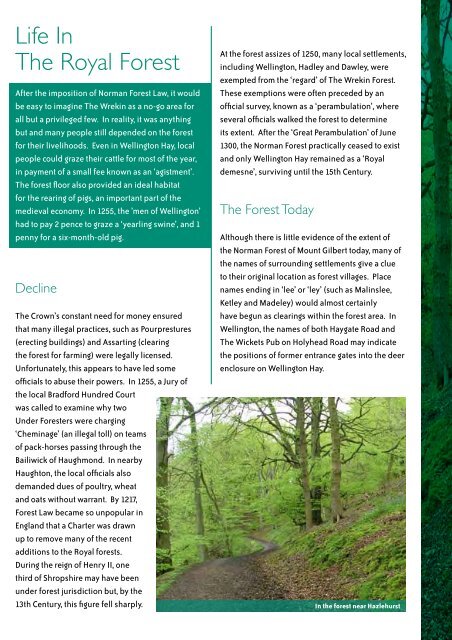All Round The Wrekin - Wellington Local Agenda 21 Group
All Round The Wrekin - Wellington Local Agenda 21 Group
All Round The Wrekin - Wellington Local Agenda 21 Group
Create successful ePaper yourself
Turn your PDF publications into a flip-book with our unique Google optimized e-Paper software.
Life In<br />
<strong>The</strong> Royal Forest<br />
After the imposition of Norman Forest Law, it would<br />
be easy to imagine <strong>The</strong> <strong>Wrekin</strong> as a no-go area for<br />
all but a privileged few. In reality, it was anything<br />
but and many people still depended on the forest<br />
for their livelihoods. Even in <strong>Wellington</strong> Hay, local<br />
people could graze their cattle for most of the year,<br />
in payment of a small fee known as an ‘agistment’.<br />
<strong>The</strong> forest floor also provided an ideal habitat<br />
for the rearing of pigs, an important part of the<br />
medieval economy. In 1255, the ’men of <strong>Wellington</strong>’<br />
had to pay 2 pence to graze a ‘yearling swine’, and 1<br />
penny for a six-month-old pig.<br />
Decline<br />
<strong>The</strong> Crown’s constant need for money ensured<br />
that many illegal practices, such as Pourprestures<br />
(erecting buildings) and Assarting (clearing<br />
the forest for farming) were legally licensed.<br />
Unfortunately, this appears to have led some<br />
officials to abuse their powers. In 1255, a Jury of<br />
the local Bradford Hundred Court<br />
was called to examine why two<br />
Under Foresters were charging<br />
‘Cheminage’ (an illegal toll) on teams<br />
of pack-horses passing through the<br />
Bailiwick of Haughmond. In nearby<br />
Haughton, the local officials also<br />
demanded dues of poultry, wheat<br />
and oats without warrant. By 1<strong>21</strong>7,<br />
Forest Law became so unpopular in<br />
England that a Charter was drawn<br />
up to remove many of the recent<br />
additions to the Royal forests.<br />
During the reign of Henry II, one<br />
third of Shropshire may have been<br />
under forest jurisdiction but, by the<br />
13th Century, this figure fell sharply.<br />
At the forest assizes of 1250, many local settlements,<br />
including <strong>Wellington</strong>, Hadley and Dawley, were<br />
exempted from the ‘regard’ of <strong>The</strong> <strong>Wrekin</strong> Forest.<br />
<strong>The</strong>se exemptions were often preceded by an<br />
official survey, known as a ‘perambulation’, where<br />
several officials walked the forest to determine<br />
its extent. After the ‘Great Perambulation’ of June<br />
1300, the Norman Forest practically ceased to exist<br />
and only <strong>Wellington</strong> Hay remained as a ‘Royal<br />
demesne’, surviving until the 15th Century.<br />
<strong>The</strong> Forest Today<br />
Although there is little evidence of the extent of<br />
the Norman Forest of Mount Gilbert today, many of<br />
the names of surrounding settlements give a clue<br />
to their original location as forest villages. Place<br />
names ending in ‘lee’ or ‘ley’ (such as Malinslee,<br />
Ketley and Madeley) would almost certainly<br />
have begun as clearings within the forest area. In<br />
<strong>Wellington</strong>, the names of both Haygate Road and<br />
<strong>The</strong> Wickets Pub on Holyhead Road may indicate<br />
the positions of former entrance gates into the deer<br />
enclosure on <strong>Wellington</strong> Hay.<br />
In the forest near Hazlehurst


